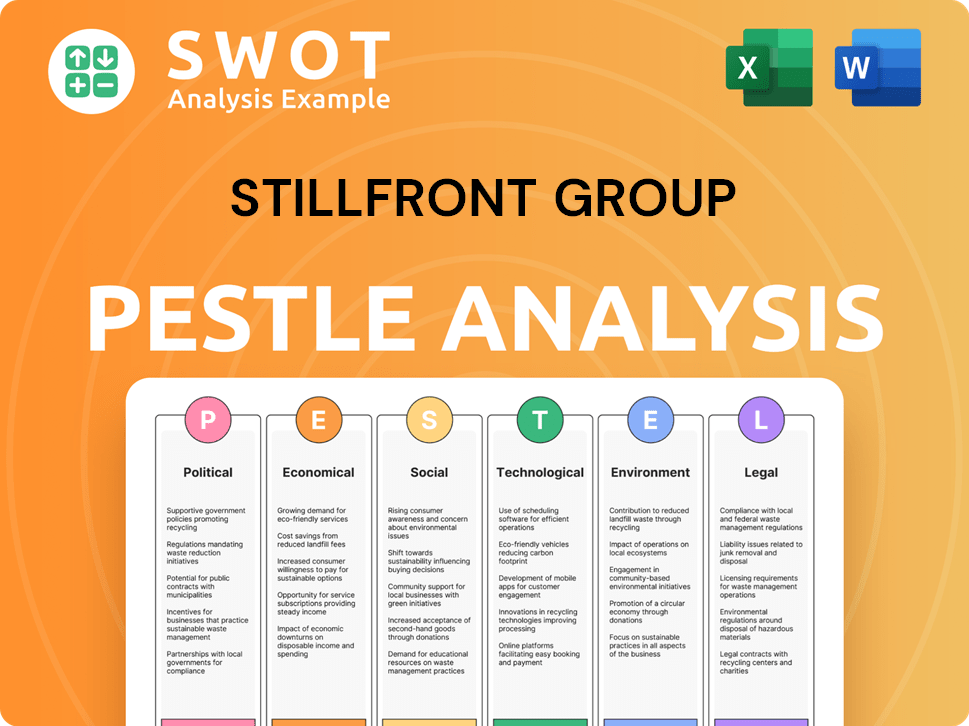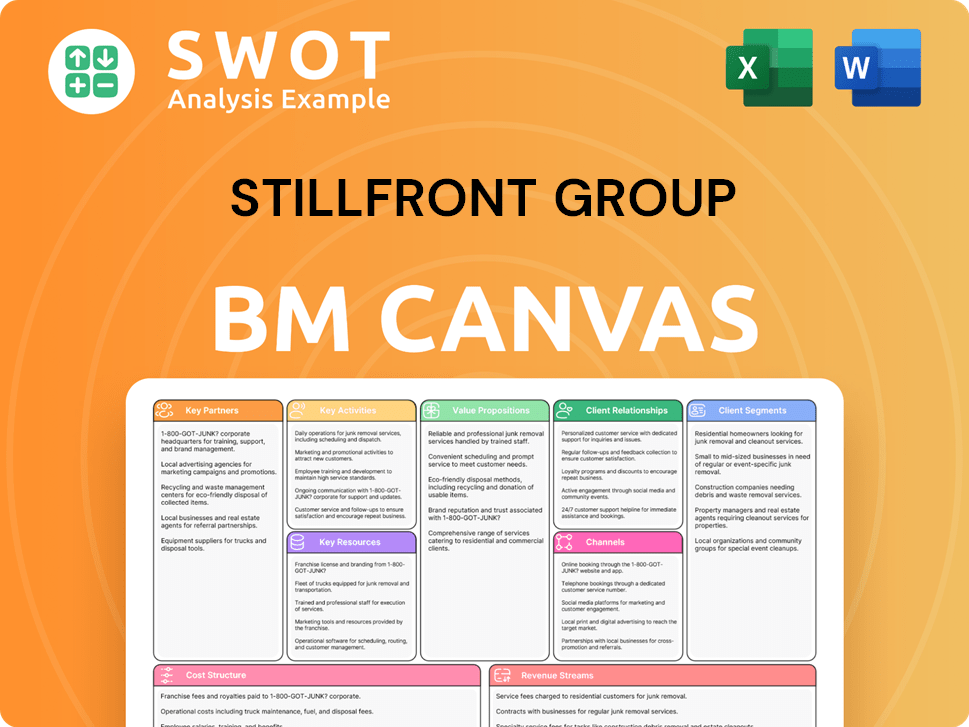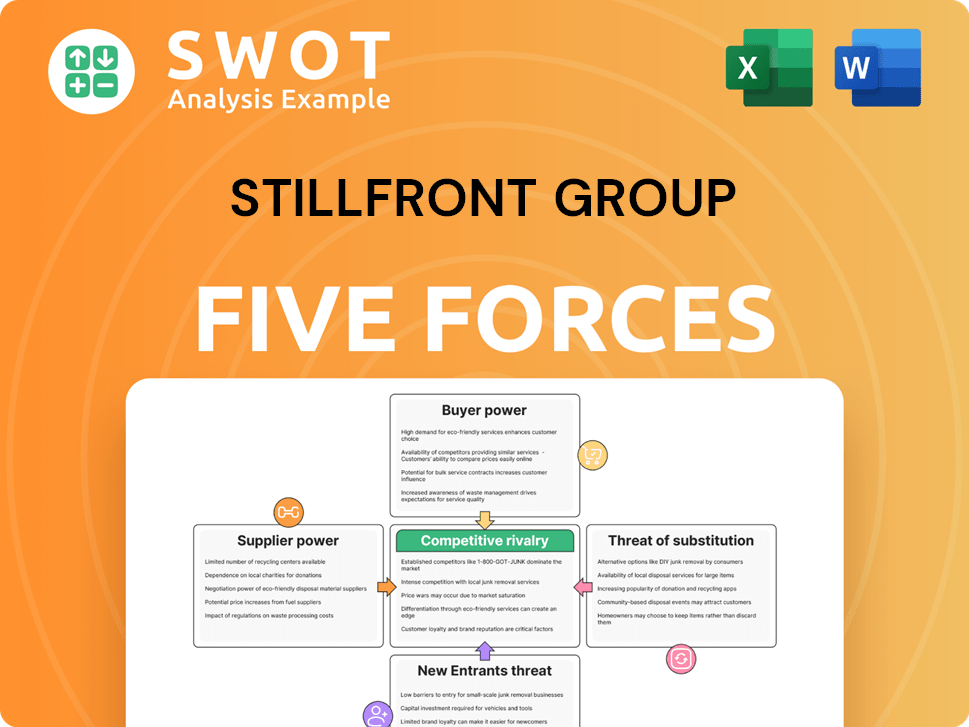Stillfront Group Bundle
How Did Stillfront Group Conquer the Gaming World?
Embark on a journey through the fascinating Stillfront Group SWOT Analysis, a leading force in the global gaming market. From its humble beginnings in Stockholm, Sweden, to its current status as a prominent player, Stillfront's story is one of strategic acquisitions and innovative game development. Discover how this gaming company has navigated the dynamic world of mobile games and built a diverse portfolio that captivates millions.

The Stillfront Group's history is a compelling narrative of growth, driven by a unique business model focused on acquiring and nurturing independent game studios. Founded by Jörgen Larsson, the company's strategic approach has allowed it to amass a substantial portfolio of long-lifecycle games, attracting nearly 47 million monthly active users. Understanding the Stillfront company profile provides valuable insights into the evolution of the mobile gaming industry and the strategies that fuel success.
What is the Stillfront Group Founding Story?
The story of Stillfront Group begins in 2010, when Swedish entrepreneur Jörgen Larsson laid the groundwork for what would become a significant player in the gaming industry. Operations officially began in 2012. Larsson envisioned a company that would build a diverse collection of enduring games.
Larsson's approach was to acquire independent gaming studios. These studios would keep their operational independence within the group. This model aimed to use the creativity and expertise of individual studios. It would also give them the resources and stability of a larger entity. The initial focus was on the fragmented nature of the free-to-play online games market. The goal was to consolidate successful, long-lifecycle titles under a unified strategy.
The initial business model centered on acquiring established or promising game studios. This gave access to their existing game portfolios and development talent. The first major acquisition was in November 2012. It was Power Challenge, a developer and publisher of mobile and browser-based social sports management games. This acquisition expanded Stillfront's offerings and solidified its early strategy. The company's early growth was driven by strategic mergers and acquisitions, indicating a reliance on external capital. The company's focus on free-to-play mobile games and its main markets, including the US, Germany, France, and the Middle East, were established early on, shaping its trajectory from the outset.
Stillfront Group's founding was marked by a strategic vision to consolidate and grow in the free-to-play gaming market.
- Founded in 2010: Jörgen Larsson established the company, with operations starting in 2012.
- Acquisition Strategy: The core strategy involved acquiring independent gaming studios. This allowed them to maintain operational independence.
- First Acquisition: Power Challenge, a developer of social sports management games, was acquired in November 2012.
- Market Focus: Early focus on free-to-play mobile games in key markets like the US, Germany, France, and the Middle East.
The company's early success was fueled by its ability to identify and integrate promising game studios. This strategy allowed it to expand its game portfolio quickly. The acquisition of Power Challenge was a pivotal moment. It demonstrated the company's commitment to its business model.
The Target Market of Stillfront Group highlights the company's strategic focus on specific demographics and gaming preferences. This focus has been a key element in its expansion.
Stillfront Group's journey from its founding to its current status reflects a strategic approach to growth. This includes acquisitions and a focus on the free-to-play mobile gaming market. The company's history is marked by strategic decisions that have shaped its trajectory.
Stillfront Group SWOT Analysis
- Complete SWOT Breakdown
- Fully Customizable
- Editable in Excel & Word
- Professional Formatting
- Investor-Ready Format

What Drove the Early Growth of Stillfront Group?
The early growth of the Stillfront Group was marked by a strategic approach to acquisitions, aimed at building a diverse portfolio within the gaming industry. This strategy significantly shaped the Stillfront history, allowing the Stillfront company to rapidly expand its game offerings and market presence. These early moves were crucial in establishing the foundation for future growth and market positioning.
In November 2013, Stillfront Group acquired 51% of Bytro Labs, known for strategy games such as Supremacy 1914. This acquisition strengthened its position in the strategy game genre. The remaining 49% of Bytro Labs was fully acquired by 2016, showcasing a commitment to long-term investment in its acquired studios.
December 2015 was a pivotal moment for Stillfront Group as it listed its shares on NASDAQ First North Stockholm. The IPO, with an initial price of SEK 39 per share, was a key event. This move provided significant capital for further expansion and increased market visibility for the gaming company.
June 2016 saw the acquisition of a majority stake in Simutronics, adding text-based MUD-style games and mobile games to the portfolio. This acquisition broadened the company's game offerings. These strategic moves were key to the company's growth.
In December 2016, Stillfront Group acquired Babil Games, a mobile games publisher based in the Middle East and North Africa (MENA) region. This acquisition expanded the company's geographical reach. This strategic move was vital for the Stillfront company.
May 2017 marked the acquisition of eRepublik Labs, which brought titles like eRepublik and World at War: WW2 Strategy MMO into the Stillfront Group's portfolio. This acquisition enhanced the company's game lineup. This was a strategic move.
In June 2017, Stillfront Group moved its share listing to NASDAQ First North Premier Growth Market. This move reflected its growth and increasing market presence. This was a strategic move.
Stillfront Group PESTLE Analysis
- Covers All 6 PESTLE Categories
- No Research Needed – Save Hours of Work
- Built by Experts, Trusted by Consultants
- Instant Download, Ready to Use
- 100% Editable, Fully Customizable

What are the key Milestones in Stillfront Group history?
The Stillfront Group, a prominent gaming company, has achieved significant milestones through strategic acquisitions and expansions in the mobile games market. Their approach has involved acquiring various game development studios to diversify their portfolio and increase their market share. These acquisitions have been crucial in shaping the Stillfront history and its position within the gaming industry.
| Year | Milestone |
|---|---|
| January 2018 | Acquired Goodgame Studios for €270 million, significantly expanding their portfolio. |
| October 2018 | Acquired Imperia Online, focusing on long-term gamer relations. |
| December 2018 | Acquired Playa Games, a casual strategy game developer. |
| 2019 | Acquired Kixeye, a developer of massively multiplayer online real-time strategy games. |
| January 2020 | Acquired Storm8 for up to $400 million. |
| September 2020 | Acquired Nanobit for $100 million. |
| January 2021 | Acquired 6waves for $201 million. |
| September 9, 2021 | Acquired Jawaker for $205 million, diversifying offerings with Arabic online card games. |
Stillfront Group's innovations lie primarily in its aggressive acquisition strategy, which has allowed it to rapidly expand its portfolio and diversify its game genres. This focus on acquiring studios specializing in free-to-play games with long lifecycles has been a key element of their business model and market strategy.
Stillfront's primary innovation is its consistent acquisition of game development studios, which has fueled its growth. This strategy has allowed the company to quickly expand its game portfolio and enter new market segments within the mobile games industry.
The acquisitions have led to a diverse portfolio of games, including strategy, casual, and card games. This diversification helps Stillfront Group to attract a wider audience and reduce reliance on any single game or genre.
Despite its successes, Stillfront Group has faced challenges, including a 5% decline in net revenue to $153.5 million in FY 2024 and a significant non-cash goodwill impairment of $631.5 million. In response, the company initiated restructuring efforts, including a new organizational model and cost-saving measures, to improve financial performance. The company is adapting to market downturns to improve profitability and organic growth.
In FY 2024, Stillfront Group reported a 5% decrease in net revenue, totaling $153.5 million, and a 5% decrease in organic revenue. This decline highlights the challenges the company faces in maintaining growth in a competitive market.
A significant non-cash goodwill impairment of $631.5 million in FY 2024 impacted EBIT and resulted in a net loss of -$669.2 million. This impairment reflects the challenges in the valuation of acquired assets within the company's portfolio.
Stillfront Group initiated restructuring efforts, including a new organizational model with three geographical business areas as of January 1, 2025. These changes aim to streamline operations and improve efficiency.
The company has focused on cost-saving actions, such as reducing staff at Storm8 and divesting parts of Game Labs studio assets. These measures are expected to result in annualized run-rate cost savings of SEK 200-250 million by Q4 2025.
Stillfront Group Business Model Canvas
- Complete 9-Block Business Model Canvas
- Effortlessly Communicate Your Business Strategy
- Investor-Ready BMC Format
- 100% Editable and Customizable
- Clear and Structured Layout

What is the Timeline of Key Events for Stillfront Group?
The Stillfront Group, a prominent gaming company, has a rich history marked by strategic acquisitions and significant organizational changes. Founded in 2010 by Jörgen Larsson in Sweden, the company began its operations in 2012 and has since expanded its portfolio through numerous acquisitions. A key milestone was the IPO in 2015, which saw the company listed on the NASDAQ First North Stockholm. Stillfront's growth continued with acquisitions of various game development studios, including Goodgame Studios, Nanobit, and Jawaker. In recent developments, the company has reorganized its operations into three geographical business areas and is implementing cost-saving initiatives to improve profitability.
| Year | Key Event |
|---|---|
| 2010 | Stillfront Group was founded by Jörgen Larsson in Sweden. |
| 2012 | Stillfront began operations and acquired Power Challenge. |
| 2013 | Stillfront acquired 51% of Bytro Labs. |
| 2015 | Stillfront completed its IPO and listed shares on NASDAQ First North Stockholm. |
| 2016 | The company acquired Simutronics and Babil Games. |
| 2017 | Stillfront acquired eRepublik Labs; shares moved to NASDAQ First North Premier Growth Market. |
| 2018 | The company acquired Goodgame Studios, Imperia Online, and Playa Games. |
| 2019 | Stillfront acquired Kixeye. |
| January 2020 | The company acquired Storm8 for up to $400 million. |
| September 2020 | Stillfront acquired Nanobit for $100 million. |
| January 2021 | Stillfront announced its intent to acquire 6waves for $201 million. |
| September 2021 | Stillfront acquired Jawaker for $205 million. |
| January 2022 | The company completed the acquisition of 6waves. |
| FY 2024 | Stillfront reported a 5% decline in net revenue to $153.5 million and a net result of -$669.2 million. |
| January 1, 2025 | The company reorganized operations into three geographical business areas: Europe, North America, and MENA & APAC. |
| Q1 2025 | Stillfront reported net revenue of SEK 1,545 million (down 12% organically from Q1 2024) and net results of SEK 23 million. |
| April 2025 | Stillfront completed the transfer of 24 Storm8 legacy games to Imperia as part of cost-saving initiatives. |
| May 2025 | The company launched the Supremacy Franchise. |
Stillfront is focused on accelerating its synergy phase and optimizing its management structure. The company aims to strengthen shared services to support core game teams. These efforts are designed to streamline operations and improve overall efficiency. This strategic approach is crucial for long-term growth.
Cost-saving actions are a key part of Stillfront's strategy. This includes moving declining games to lower-cost locations and addressing low-performing games. The company is targeting annual run-rate cost savings of SEK 200-250 million by Q4 2025. These savings will help improve profitability.
Stillfront is rolling out Direct To Consumer (DTC) solutions for larger Casual games. The DTC share increased to 36% in Q1 2025 from 30% in Q1 2024. This expansion is expected to drive organic growth and improve profitability. This will strengthen the company's market position.
While Q2 2025 is expected to remain challenging in terms of topline organic growth, Stillfront anticipates continued strong cash flows and adjusted EBITDAC. The company's long-term strategy remains focused on building a diversified portfolio of long-lifecycle games. This will ensure sustainable growth.
Stillfront Group Porter's Five Forces Analysis
- Covers All 5 Competitive Forces in Detail
- Structured for Consultants, Students, and Founders
- 100% Editable in Microsoft Word & Excel
- Instant Digital Download – Use Immediately
- Compatible with Mac & PC – Fully Unlocked

Related Blogs
- What is Competitive Landscape of Stillfront Group Company?
- What is Growth Strategy and Future Prospects of Stillfront Group Company?
- How Does Stillfront Group Company Work?
- What is Sales and Marketing Strategy of Stillfront Group Company?
- What is Brief History of Stillfront Group Company?
- Who Owns Stillfront Group Company?
- What is Customer Demographics and Target Market of Stillfront Group Company?
Disclaimer
All information, articles, and product details provided on this website are for general informational and educational purposes only. We do not claim any ownership over, nor do we intend to infringe upon, any trademarks, copyrights, logos, brand names, or other intellectual property mentioned or depicted on this site. Such intellectual property remains the property of its respective owners, and any references here are made solely for identification or informational purposes, without implying any affiliation, endorsement, or partnership.
We make no representations or warranties, express or implied, regarding the accuracy, completeness, or suitability of any content or products presented. Nothing on this website should be construed as legal, tax, investment, financial, medical, or other professional advice. In addition, no part of this site—including articles or product references—constitutes a solicitation, recommendation, endorsement, advertisement, or offer to buy or sell any securities, franchises, or other financial instruments, particularly in jurisdictions where such activity would be unlawful.
All content is of a general nature and may not address the specific circumstances of any individual or entity. It is not a substitute for professional advice or services. Any actions you take based on the information provided here are strictly at your own risk. You accept full responsibility for any decisions or outcomes arising from your use of this website and agree to release us from any liability in connection with your use of, or reliance upon, the content or products found herein.